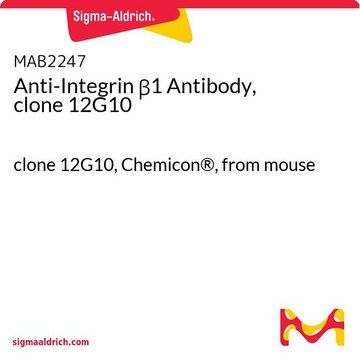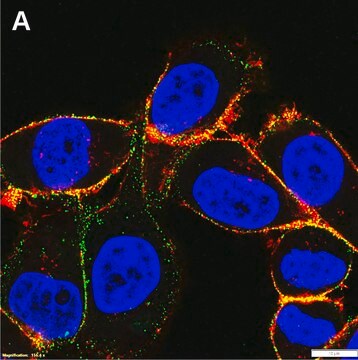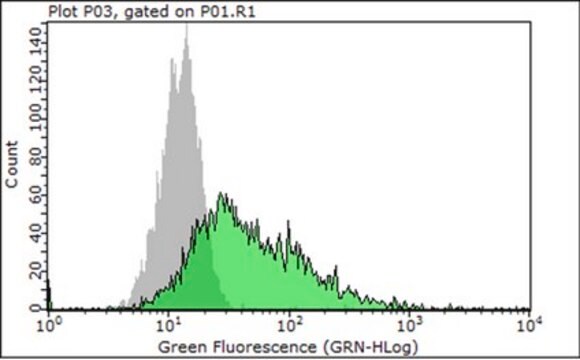MAB1959
Anti-Integrin β1 Antibody, clone P5D2
clone P5D2, Chemicon®, from mouse
Synonym(e):
CD29, MAB1959Z
About This Item
Empfohlene Produkte
Biologische Quelle
mouse
Qualitätsniveau
Antikörperform
purified immunoglobulin
Antikörper-Produkttyp
primary antibodies
Klon
P5D2, monoclonal
Speziesreaktivität
human
Hersteller/Markenname
Chemicon®
Methode(n)
ELISA: suitable
flow cytometry: suitable
immunocytochemistry: suitable
immunohistochemistry: suitable
immunoprecipitation (IP): suitable
Isotyp
IgG2bκ
NCBI-Hinterlegungsnummer
UniProt-Hinterlegungsnummer
Versandbedingung
wet ice
Posttranslationale Modifikation Target
unmodified
Angaben zum Gen
human ... ITGB1(3688)
Allgemeine Beschreibung
Spezifität
Immunogen
Anwendung
Zellstruktur
Integrine
Immunohistochemistry: A representative lot of this antibody clone was used in immunohistochemistry (acetone fixation, no paraffin embedding).
ELISA: A representative lot of this antibody was used in ELISA.
Immunocytochemistry: A representative lot of this antibody clone was used in immunocytochemistry (paraformaldehyde fixation at less than 4%).
Functional Activity Assay: A representative lot of this antibody clone was used in cell attachment assay of SV-HFO cells with a characteristic spread morphology. In the presence of function-blocking mAbs to β1 integrin (P5D2), the cells attached but no longer spread, and displayed a rounded morphology with many cytoplasmic projections (Iba, K. et al., 2000).
Qualität
4 µg of the antibody was used to detect Integrin β1 in 1x10^6 A431 cells.
4 µg of the antibody was used to detect Integrin β1 in 1x10^6 HeLa cells.
Physikalische Form
Lagerung und Haltbarkeit
Hinweis zur Analyse
Human tonsil, human skin tissue
A431 & HeLa Cells
Sonstige Hinweise
Rechtliche Hinweise
Haftungsausschluss
Sie haben nicht das passende Produkt gefunden?
Probieren Sie unser Produkt-Auswahlhilfe. aus.
Empfehlung
Lagerklassenschlüssel
10 - Combustible liquids
WGK
WGK 2
Flammpunkt (°F)
Not applicable
Flammpunkt (°C)
Not applicable
Analysenzertifikate (COA)
Suchen Sie nach Analysenzertifikate (COA), indem Sie die Lot-/Chargennummer des Produkts eingeben. Lot- und Chargennummern sind auf dem Produktetikett hinter den Wörtern ‘Lot’ oder ‘Batch’ (Lot oder Charge) zu finden.
Besitzen Sie dieses Produkt bereits?
In der Dokumentenbibliothek finden Sie die Dokumentation zu den Produkten, die Sie kürzlich erworben haben.
Unser Team von Wissenschaftlern verfügt über Erfahrung in allen Forschungsbereichen einschließlich Life Science, Materialwissenschaften, chemischer Synthese, Chromatographie, Analytik und vielen mehr..
Setzen Sie sich mit dem technischen Dienst in Verbindung.







